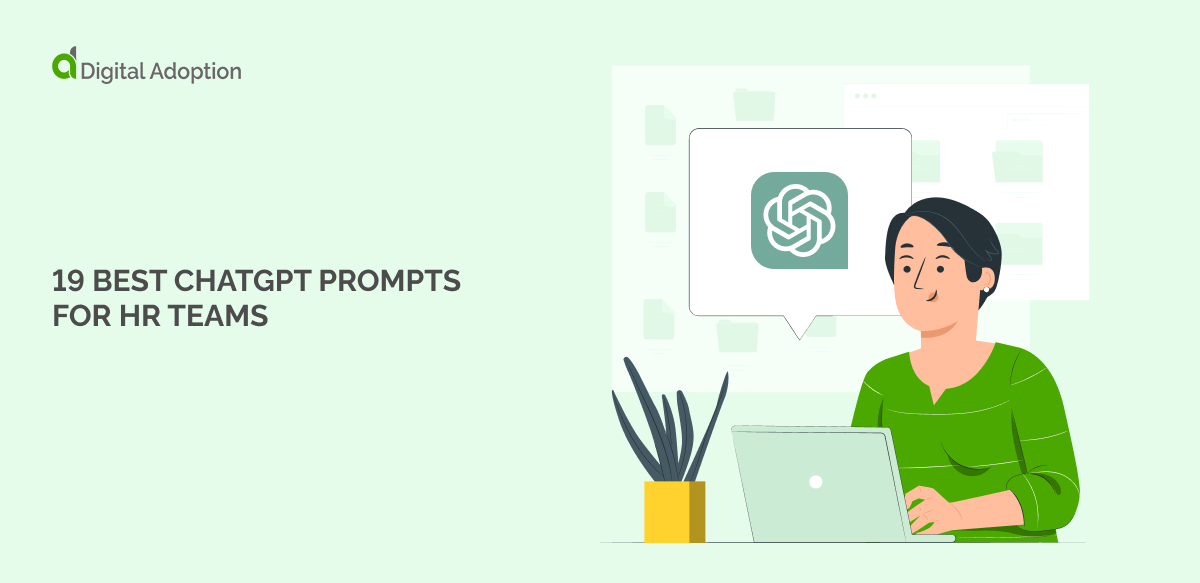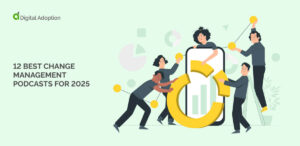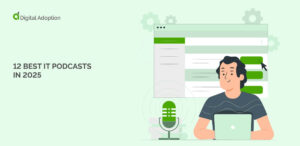ChatGPT has many uses and can be especially helpful for HR teams for recruiting and supporting staff.
Sources valued the global AI market, including tools like ChatGPT, at USD 454.12 billion in 2022. And 89.3% of companies use ChatGPT. These statistics highlight a technology many competitors may use, indicating the need to invest today to retain your digital resilience.
However, for teams that have yet to adopt AI tools like ChatGPT, knowing where to start and which prompts to use for which use case and department can be challenging.
We used this scenario as the basis for this article, where we separate use cases for ChatGPT prompts for HR teams. First, you will find some tips on how to use ChatGPT in HR.
Next, the article moves on to departments of the employee lifecycle. As new hires become interested in working for an organization at the talent advertising stage, the company recruits them. It uses generative AI tools as part of its digital onboarding best practices.
After this, HR teams can use ChatGPT prompts to carry out retention and employee engagement, training and development, and the often overlooked offboarding checklist.
Read below to discover the best ways to leverage ChatGPT to optimize these HR stages for higher efficiency and better employee outcomes.
Points to consider before you use ChatGPT in HR
Many organizations have yet to implement generative AI tools. If your experience with ChatGPT is limited, be aware of the elements of an effective prompt before implementing it into your future of work strategy.
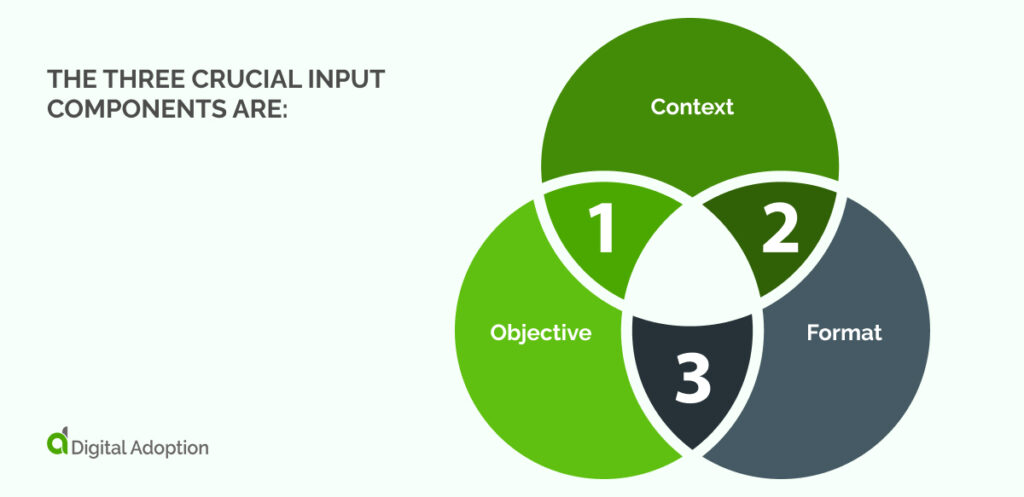
The three crucial input components are:
- Objective: What do you want to achieve with the prompt (how do you want to improve your company)?
- Context: What are the background factors for the prompt (type and size of company)?
- Format: What format do you want the result to come in (paragraphs, bullet points)?
Using these three components to signpost ChatGPT to precisely what you want is essential. This approach should give you accurate results every time.
The easiest way to understand these prompts is by looking at a few examples.
Examples of each of these elements within HR include:
- Objective: Enhance employee engagement.
- Context: Within a multinational corporation undergoing a merger.
- Format: Provide actionable strategies in a bulleted list format.
As you can see in the example above, following these three elements should always help ChatGPT generate the results you need.
But be patient with yourself and take time to play around with this tool before using it for enterprise applications.
Try it for household tasks like writing poems for loved ones or gift ideas. Once you are confident creating AI prompts, ChatGPT should give you consistent results you can use to support employees within your HR role.
Talent advertising
In talent acquisition, ChatGPT aids HR by crafting compelling job descriptions, optimizing recruitment campaigns, and suggesting effective candidate screening criteria. It accelerates the hiring process, attracts top talent, and ensures alignment between job roles and organizational needs, facilitating efficient talent acquisition.
- Crafting a job description
“Compose a job description for a [specified position]. Detail responsibilities encompassing [A, B & C].”
This prompt lets you generate a customizable job description template tailored to your role’s requirements and company specifics.
- Building a career page
“List the top 10 components of a company’s career page.”
This prompt can offer HR professionals a simple guide. It effectively structures the organization’s career page, aiding its development or enhancement.
- Crafting employer branding messages for social media
“Outline seven key practices for crafting compelling employer branding content on company social media platforms.”
This prompt provides insights into vital employer branding strategies for engaging your target audience effectively, with the option to specify industry or company type for tailored responses.
Recruiting
ChatGPT accelerates candidate sourcing for the recruitment team by generating tailored job postings, crafting engaging outreach messages, and suggesting interview questions. It streamlines resume screening, enhances candidate evaluation, and optimizes hiring, leading to efficient and effective recruitment outcomes.
- Creating screening interview queries
“Craft 10 inquiries for a preliminary screening interview targeting [insert job title].”
This task equips you with questions for selection, inspiration, or integration into your interview process.
- Developing specific interview queries
“List five interview queries evaluating managerial adeptness. Each should detail ideal responses from adept candidates and contrasting responses from less skilled candidates.”
You can adapt this to include varied proficiencies or additional behavioral or technical inquiries suitable for diverse candidate profiles or interview scenarios.
- Implementing inclusive hiring strategies
“Outline eight practices fostering inclusivity in hiring. Considering these practices, what obstacles might HR departments encounter?”
The first section, split into two sections, provides strategies for cultivating inclusivity within your recruitment approach. The second guides you in assessing potential hurdles while implementing inclusive hiring methods.
Onboarding process
ChatGPT facilitates a seamless transition for new hires during onboarding by generating personalized training materials, creating welcome messages, and outlining orientation schedules. It ensures consistency, clarity, and engagement, fostering a positive and productive introduction to the organization’s culture and processes.
- Crafting welcome correspondence
“Draft a welcoming email for a new hire in a specified role, embodying the tone of [insert your company’s name].”
ChatGPT is adaptable to diverse writing styles and tones, including your organization’s, although it’s advisable to review for alignment with your brand voice. Optionally, specify the desired conversational, formal, or professional tone.
- Compiling common queries
“List 5 frequently asked questions posed by newly onboarded employees with answers for each question.”
This prompt aids HR practitioners in anticipating common queries from new hires. You can further personalize by specifying a particular role (e.g., account executive, customer service representative) or industry (e.g., retail, healthcare).
- Outlining onboarding strategies
“Outline five optimal practices for facilitating the onboarding of fresh staff.”
These fundamental factors provide a solid foundation for designing an effective onboarding process. To enhance ChatGPT’s insights, inquire further for actionable steps.
- Designing evaluation surveys
“Construct an evaluation survey for onboarding, comprising ten questions administered after the employee’s initial 30 days.”
Incorporating inclusion criteria, such as “Include at least one query regarding manager feedback,” ensures that the survey is tailored to specific requirements.
Retention and employee engagement
In retention and employee engagement, ChatGPT suggests recognition strategies, designs surveys to gauge satisfaction, and generates communication materials to foster a positive work environment. It enhances morale, strengthens employee relationships, and identifies areas for improvement, leading to increased retention and engagement levels.
- Generating engagement inquiries
“Formulate five survey questions aimed at gauging employee engagement, emphasizing aspects of company culture while excluding inquiries concerning management.”
This approach enables HR professionals to readily devise a set of foundational queries suitable for inclusion in their engagement surveys.
Further customization can be achieved by specifying additional exclusion or inclusion criteria.
- Crafting compensation strategies
“List seven steps HR professionals should adhere to when formulating a compensation strategy.”
This guidance helps HR personnel develop the company’s compensation strategy. To refine the process, consider incorporating company size, location, or seniority-level details.
- Proposing recognition initiatives
“Compile a list of 10 non-monetary methods for acknowledging employee contributions.”
This directive is a source of inspiration for HR professionals seeking to establish or enhance their employee recognition initiatives.
- Formulating work policies
“Create a telecommuting policy to include in an employee handbook.”
Utilizing a template generated by ChatGPT facilitates the creation of a comprehensive work-from-home policy, ensuring clarity and coherence to meet the organization’s specific requirements through further refinement.
- Outlining essential HR policies
“Outline ten key HR policies essential for an organization with [insert number] of employees operating in [insert industry].”
This prompt furnishes an overview of critical HR policies necessary for regulatory compliance and clarity on various HR-related matters within the organization.
Training and development
ChatGPT can support employee training and development by designing customized learning modules, suggesting skill enhancement opportunities, and generating performance feedback templates. It accelerates skill acquisition, promotes continuous growth, and empowers employees to reach their full potential, enhancing organizational effectiveness.
- Curriculum on training initiatives
“Present five online training programs tailored for HR Analytics and provide a concise overview of each.”
This instruction directs you to curated courses specifically designed for HR Analytics. However, it’s essential to note that while ChatGPT’s data is up to September 2021, some courses may have become obsolete, or newer ones may not be covered.
- Employee coaching inquiries
“Compile ten coaching questions geared towards employees in a designated role.”
This task helps generate a set of queries that are helpful in enhancing various aspects of employee performance, such as guiding managers in conducting effective performance evaluations with their team members.
Offboarding/ exit process
ChatGPT generates exit interview questions during offboarding, creates checklist templates, and drafts departure communications.
It ensures a smooth transition for departing employees, gathers valuable feedback for improvement, and maintains professionalism throughout the departure process, safeguarding organizational reputation.
- Generating departure guidelines
“Develop an employee departure checklist tailored for HR.”
This task offers HR professionals a comprehensive guide with essential tasks to complete when employees leave the company. It features checkboxes for tracking progress.
- Crafting departure notifications
“Compose a corporate email announcing an employee’s departure.”
HR personnel or the exiting employee’s manager can utilize this prompt to generate a standardized template for notifying company staff about an employee’s departure.
You can include additional specifications, such as tone of voice or email personalization (e.g., mentioning the position or department), as desired.
Best practices for using ChatGPT prompts for HR
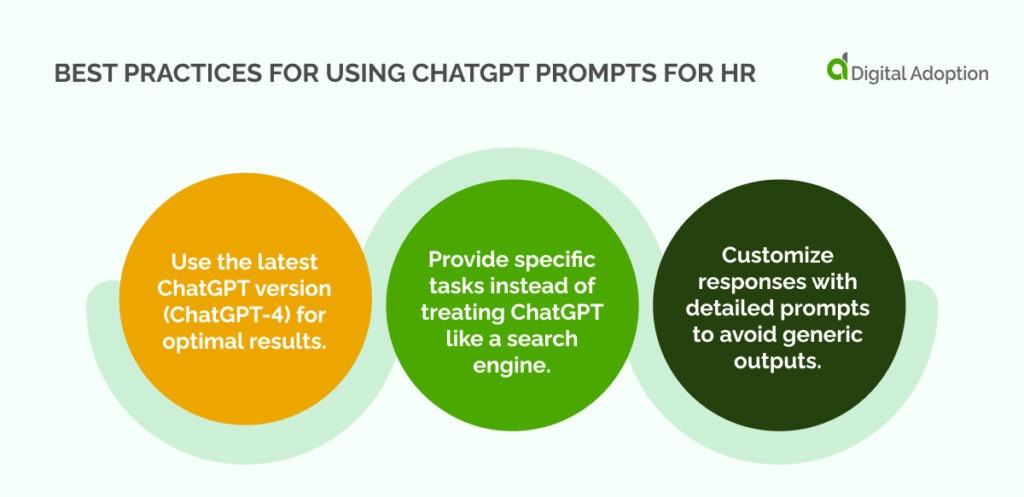
The introduction of ChatGPT has only occurred in a few organizations. This point means that many organizations will have staff facing overwhelming challenges when they receive a request to use generative AI tools.
Following these best practices for ChatGPT prompts can help your HR team use this tool effectively. Doing so will ensure higher employee retention and a more efficient ROI.
- Opt for the most recent ChatGPT version, currently ChatGPT-4, for optimal results. Each update substantially enhances output quality, ensuring superior performance and maximizing productivity.
- Avoid treating ChatGPT like a search engine; present precise, specific tasks to prompt accurate responses.
- Enhance response customization by providing detailed prompts and minimizing generic outputs.
- Use prompt chaining, supplementary instructions, and follow-up queries to refine results effectively and extract more profound insights. This iterative process enhances the quality and relevance of ChatGPT-generated content.
Using these best practices can save you time and money, so pass them on to your HR team before rolling out ChatGPT to help them hit the ground running when you need them to begin using it.
Split prompts into HR departments for high success rates
You can split the most valuable and easy-to-use ChatGPT HR prompts into the six categories of HR stages. These are talent advertising, recruiting, onboarding, retention and engagement, training and development, and offboarding.
Splitting the prompts into these groups allows you to be systemic and focused in approaching every prompt. You can then tailor the learning to each HR department and each use case to maximize effectiveness and lower adoption times.
Adopt ChatGPT within your HR team today to get the edge over competitors, become one of your most effective AI productivity tools, and leverage generative AI for better staff well-being and higher revenue.

